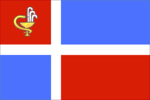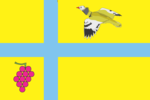
The national flag of Sweden consists of a yellow or gold Nordic cross on a field of light blue. The Nordic cross design traditionally represents Christianity. The design and colours of the Swedish flag are believed to have been inspired by the present coat of arms of Sweden of 1442, which is blue divided quarterly by a cross pattée of gold. Blue and yellow have been used as Swedish colours at least since Magnus III's royal coat of arms of 1275.

The national flag of Finland, also known in Finnish as the Siniristilippu, dates from the beginning of the 20th century. On a white background, it features a blue Nordic cross, which represents Christianity.

A saltire, also called Saint Andrew's Cross or the crux decussata, is a heraldic symbol in the form of a diagonal cross. The word comes from the Middle French sautoir, Medieval Latin saltatoria ("stirrup").

The national flag of Switzerland displays a white cross in the center of a square red field. The white cross is known as the Swiss cross or the federal cross. Its arms are equilateral, and their ratio of length to width is 7:6. The size of the cross in relation to the field was set in 2017 as 5:8. Alongside the flag of Vatican City, the Swiss flag is one of only two square national flags in the world.
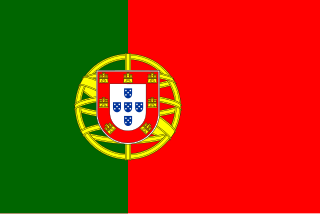
The national flag of the Portuguese Republic, often referred to as the Portuguese flag consists of a rectangular bicolour with a field divided into green on the hoist, and red on the fly. A lesser version of the country’s national coat of arms stands in the middle of the Portuguese armillary sphere and shield, centered over the colour boundary at equal distance. The flag was announced in 1910, following the 5 October 1910 revolution, inspired by the colours of the Republican Party and the design of radical conspiratorial society Carbonária.
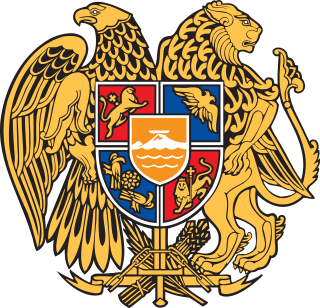
The national coat of arms of Armenia was adopted on April 19, 1992, by resolution of the Armenian Supreme Council. On June 15, 2006, the Armenian Parliament passed the law on the state coat of arms of Armenia.

The coat of arms of Australia, officially the Commonwealth Coat of Arms, is a formal symbol of the Commonwealth of Australia. It depicts a shield, containing symbols of Australia's six states, and is held up by native Australian animals, the kangaroo and the emu. The seven-pointed Commonwealth Star surmounting the crest also represents the states and territories, while golden wattle, the national floral emblem, appears below the shield.
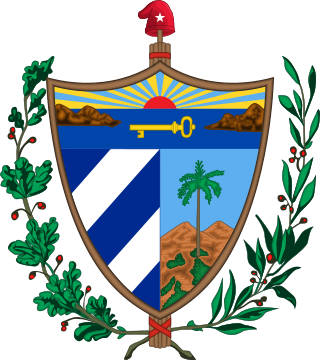
The Cuban coat of arms is the official heraldic symbol of Cuba. It consists of a shield, in front of a fasces crowned by the Phrygian cap, all supported by an oak branch on one side and a laurel wreath on the other. The coat of arms was created by Miguel Teurbe Tolón in 1849. The current version is not exactly the same as the original, since some elements related to annexationist ideas were removed. The design specifications of the shield were established by decree by the first president of Cuba, Tomás Estrada Palma, on 21 April 1906.

The coat of arms of Romania was adopted in the Romanian Parliament on 10 September 1992 as a representative coat of arms for Romania. The current coat of arms is based on the lesser coat of arms of interwar Kingdom of Romania, which was designed in 1921 by the Transylvanian Hungarian heraldist József Sebestyén from Cluj, at the request of King Ferdinand I of Romania, it was redesigned by Victor Dima. As a central element, it shows a golden aquila holding a cross in its beak, and a mace and a sword in its claws. It also consists of the three colors which represent the colors of the national flag. The coat of arms was augmented on 11 July 2016 to add a representation of the Steel Crown of Romania.

A cross pattée, cross patty or Pate, or cross paty, also known as a cross formy or cross formée or Templar cross, is a type of Christian cross with arms that are narrow at the centre, and often flared in a curve or straight line shape, to be broader at the perimeter. The form appears very early in medieval art, for example in a metalwork treasure binding given to Monza Cathedral by Lombard queen Theodelinda, and the 8th-century lower cover of the Lindau Gospels in the Morgan Library. An early English example from the start of the age of heraldry proper is found in the arms of Baron Berkeley.
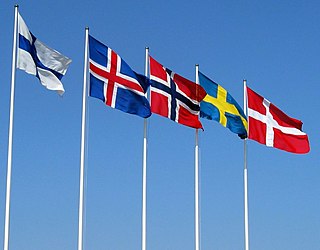
A Nordic cross flag is a flag bearing the design of the Nordic or Scandinavian cross, a cross symbol in a rectangular field, with the centre of the cross shifted towards the hoist.

The coat of arms of Portugal is the main heraldic insignia of Portugal. The present model was officially adopted on 30 June 1911, along with the present model of the Flag of Portugal. It is based on the coat of arms used by the Kingdom of Portugal since the Middle Ages. The coat of arms of Portugal is popularly referred as the Quinas.
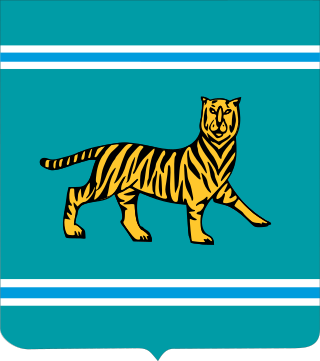
The coat of arms of the Jewish Autonomous Oblast is the official coat of arms of the Jewish Autonomous Oblast in Russia. It consists of a Siberian tiger standing on four legs with the tail and the head turned upwards, of which the latter is facing the observer. This specific position and occurrence of the tiger symbolizes the history and development of the Oblast. The emblem is a heraldic French shield and the background represents the color of the geographical characteristics of the Russian Far East, which includes taigas, hills, and meadows.

The flag of Perm Krai in Russia is a rectangular panel divided by a white cross, which is the St. George's Cross of the patron of Russia, charged with the coat of arms of the krai in the centre. The corners of the panel are divided into two colours: red at the top-left and bottom-right, and blue at the top-right and bottom-left. The flag was, until 2004, the flag of the Perm Oblast, which was merged with Komi-Permyak Autonomous Okrug to form Perm Krai.
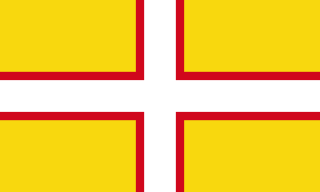
The flag of Dorset is the flag of the English county of Dorset. It was chosen as the flag of Dorset on 16 September 2008 following a vote open to all Dorset residents, and organised by Dorset County Council. The unitary authorities of Bournemouth and Poole declined an invitation to participate. The flag has subsequently been registered at the Flag Institute and added to their UK Flags Register.
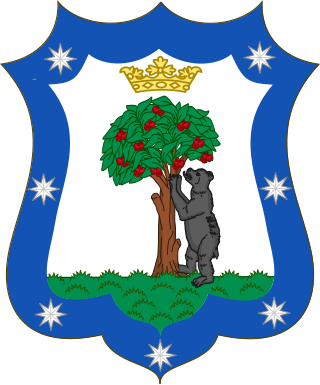
The bear as heraldic charge is not as widely used as the lion, boar or other beasts.

The Flag of the Church in Wales is the flag used to represent the Church in Wales. It consists of a blue cross on a white background with a gold celtic cross in the centre. It was adopted in 1954 by the Governing Body of the Church in Wales.

The flag that serves as the symbol of the historical and geographical regions of the Silesia, and Lower Silesia, and as one of the symbols of the Silesian people, is divided horizontally into two stripes: white on the top and yellow on the bottom. It originated as the flag of the Province of Silesia, used from 1882 to 1919, that later used as the flag of the Province of Lower Silesia, from 1920 to 1935. Currently, the flag is recognized symbol of the Silesian people in the state of Saxony in Germany.

The anthem of Kamchatka Krai, a krai in far eastern Russia, was adopted in Law of Kamchatka Krai No. 397 of 5 March 2010, "On the Anthem of Kamchatka Krai". The lyrics were written by Boris Dubrovin, and the music was composed by Evgeniy Morozov. The law introducing the anthem came into force on 1 July 2010, the anniversary of the Krai's creation on 1 July 2007.

The flag of the Świętokrzyskie Voivodeship, Poland is a rectangle divided into four parts. Its left part features a yellow vertical stripe, which wight equals to 1:4 of the wight of the flag. Its right part is divided into three horizontal stripes, that are, from top to bottom: blue, white, and red. In the middle of the white stripe is placed the coat of arms of the voivodeship. The first version of the flag had been adopted in 2001, and current version is used since 2013.













